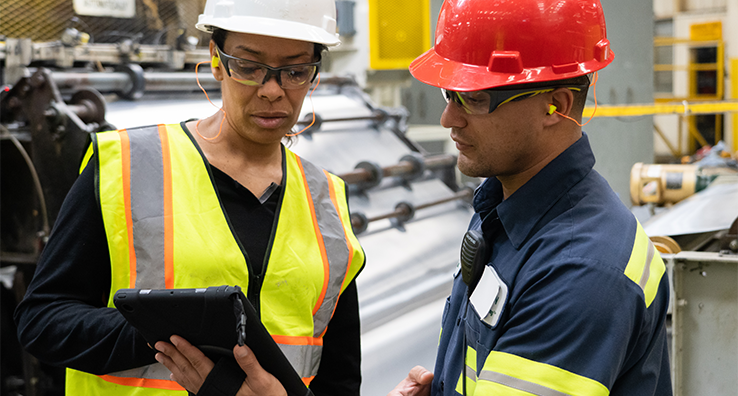5 Ways to Accelerate New Employee Onboarding and Increase Retention

Knowing how to successfully onboard a new frontline worker can mean the difference between employees staying with you for the long run versus having a high turnover rate. In fact, Glassdoor reveals that companies that have efficient, robust onboarding processes tend to improve their retention rate by more than 80%. As an added bonus, employee productivity is about 70% higher at manufacturers with an effective onboarding process.
Fortunately, with the right processes put in place, manufacturing organizations can succeed in both accelerating their new hire onboarding while improving the quality and engagement. This will help them to create a competitive advantage over other companies that still rely on manual and unengaging processes, which waste more time and can lead to ill prepared employees working the floor.
While there are a variety of ways you can strengthen your onboarding program, here are five that can take your onboarding and training program to the next level.
1. Create a Plan for New Hires Before Day 1
The saying “those who fail to plan, plan to fail” applies here. Creating a robust plan for onboarding new hires will help you to successfully integrate them into your company culture and accelerate your onboarding process. While having an onboarding program isn’t a novelty in the manufacturing industry, for many organizations it is severely neglected.
A survey by Aberdeen showed that 83% of the highest performing organizations begin onboarding prior to the new hire’s first day on the job. One way to do this is to allow your new hires access to an online onboarding tool after you have received their signed job offer. They can begin to learn first day information, receive welcome messages from their manager, and discover details about their department and job responsibility.
And with this tool, you should be able to organize and track tasks and courses that need to be completed. In addition, you can provide answers to questions that they might have before their first day, such as where they should go on day one, who to ask for upon arrival, and what to wear.
2. Standardize On-the-Job Training across All Shifts and Departments
According to go2HR, 40% of employees who receive poor (or no) on-the job training leave within their first year of employment. It’s imperative for you to create robust on-the-job training for every role in your facility.
Have you ever noticed at your facility that some departments or shifts are better at training their new hires than others? This can occur when manufacturers solely rely on informal training processes like the buddy system to train their new hires. By utilizing process-driven tools that make sure each employee receives all the training they need, organizations can prevent bad practices from spreading throughout the facility.
When selecting a platform for on-the-job training, it’s important that the solution can:
- Capture videos and photos of your star performers performing job-specific tasks in the facility to easily turn it into a course
- Track employee progress in learning new tasks and earning job qualifications
- Embed quizzes throughout the course to ensure frontline workers’ comprehension and increase their engagement
- Deliver the courses to your new hires directly on the production floor, right where the job will be performed
3. Set Time Aside for Frequent Observations and Feedback Sessions
It’s important for supervisors to have regular check-ins and observations with new employees to make sure that they are comfortable, happy, and engaged. Supervisors should provide thoughtful feedback on their new hire’s early contributions during onboarding. This also strengthens the relationship between the employee and the organization that they work for.
Many manufacturing organizations already understand the value of observing their new hires during the first months, but it’s difficult to design an observation process that isn’t cumbersome. They need tools that are low on administration, but high on value.
This is the beauty of utilizing technology. Organizations can set up observations within an online tool to complete a checklist of verifications on their employees and have that information documented and managed within a central platform. From the information that they collect during observations, they can provide actionable feedback to their new hires and build a stronger connection with new employees.
4. Automate the Onboarding Process
Automating the paperwork and normal onboarding practices will increase productivity for everyone. This will allow your training team to focus more on creating engaging and efficient content for onboarding and less time having to browse through Excel or filing cabinets to get the most up-to-date status on their new hires’ progress.
Going paperless will help to streamline your onboarding process and increase efficiency, while providing much more visibility to each new hires’ onboarding progress.
5. Consistently Ask for Feedback
Your frontline workers want to feel like they can be honest and heard at their company. There is no better way to discover ways to improve your onboarding process than by asking new hires about their experience. This will help you identify, address, and resolve any red flags before they become a bigger issue.
You can perform employee surveys to give new employees the opportunity to provide honest feedback about their overall experience and the onboarding process. From the information that they provide, you will gain insight on how to improve the onboarding process.





